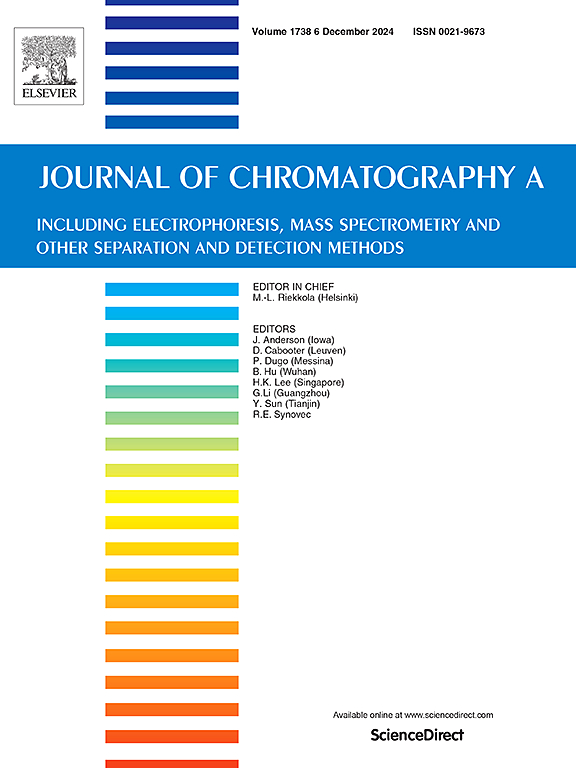Determination of particle number concentration for biological particles using AF4-MALS: Dependencies on light scattering model and refractive index
IF 4
2区 化学
Q1 BIOCHEMICAL RESEARCH METHODS
引用次数: 0
Abstract
Determining accurate counts and size distributions for biological particles (bioparticles) is crucial in wide-ranging fields, but current methods to this end are susceptible to bias from polydispersity in size. This bias can be mitigated by incorporating a separation step prior to characterization. For this reason, asymmetrical flow field-flow fractionation (AF4) with on-line multiangle light scattering (MALS) has become an important platform for determining particle size. AF4-MALS has also been increasingly used to report particle concentration, particularly for complex biological particles, yet the impact of light scattering models and particle refractive indices (RI) have not been quantitatively evaluated. Here, we develop an analysis workflow using AF4-MALS to simultaneously separate and determine particles sizes and concentrations. The impacts of the MALS particle counting model used to process data and the chosen RI value(s) on particle counts are systematically assessed for polystyrene latex (PSL) particles and bacterial outer membrane vesicles (OMVs) in the 20–500 nm size range. Across spherical models, PSL and OMV particle counts varied up to 13 % or 200 %, respectively. For the coated-sphere model used in the analysis of OMV samples, the sphere RI value greatly impacts particle counts. As the sphere RI value approaches the RI of the suspending medium, the model becomes increasingly sensitive to the light scattering signal-to-noise ratio ultimately causing erroneous particle counts. Overall, this work establishes the importance of selecting appropriate MALS models and RI values for bioparticles to obtain accurate counts and provides an AF4-MALS method to separate, enumerate, and size polydisperse bioparticles.
使用 AF4-MALS 测定生物颗粒的数量浓度:与光散射模型和折射率有关。
确定生物颗粒(生物微粒)的精确计数和粒度分布在多个领域都至关重要,但目前的方法容易受到粒度多分散性的影响。在表征之前加入分离步骤可以减轻这种偏差。因此,带有在线多角度光散射(MALS)的非对称流场-流动分馏(AF4)已成为确定粒度的重要平台。AF4-MALS 也越来越多地用于报告颗粒浓度,尤其是复杂生物颗粒的浓度,但光散射模型和颗粒折射率 (RI) 的影响尚未得到定量评估。在此,我们开发了一种使用 AF4-MALS 的分析工作流程,可同时分离并确定颗粒大小和浓度。我们系统地评估了用于处理数据的 MALS 粒子计数模型和所选 RI 值对 20-500 nm 尺寸范围内聚苯乙烯胶乳 (PSL) 粒子和细菌外膜囊泡 (OMV) 粒子计数的影响。在各种球形模型中,PSL 和 OMV 粒子数的变化分别高达 13 % 和 200 %。对于用于分析 OMV 样品的涂层球模型,球形 RI 值对颗粒计数有很大影响。当球形 RI 值接近悬浮介质的 RI 时,模型对光散射信噪比越来越敏感,最终导致错误的颗粒计数。总之,这项工作证明了为生物颗粒选择适当的 MALS 模型和 RI 值对获得精确计数的重要性,并提供了一种 AF4-MALS 方法来分离、列举和测定多分散生物颗粒的大小。
本文章由计算机程序翻译,如有差异,请以英文原文为准。
求助全文
约1分钟内获得全文
求助全文
来源期刊

Journal of Chromatography A
化学-分析化学
CiteScore
7.90
自引率
14.60%
发文量
742
审稿时长
45 days
期刊介绍:
The Journal of Chromatography A provides a forum for the publication of original research and critical reviews on all aspects of fundamental and applied separation science. The scope of the journal includes chromatography and related techniques, electromigration techniques (e.g. electrophoresis, electrochromatography), hyphenated and other multi-dimensional techniques, sample preparation, and detection methods such as mass spectrometry. Contributions consist mainly of research papers dealing with the theory of separation methods, instrumental developments and analytical and preparative applications of general interest.
 求助内容:
求助内容: 应助结果提醒方式:
应助结果提醒方式:


